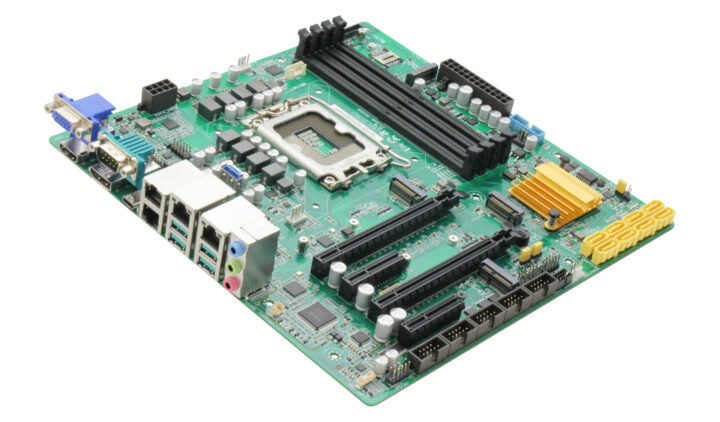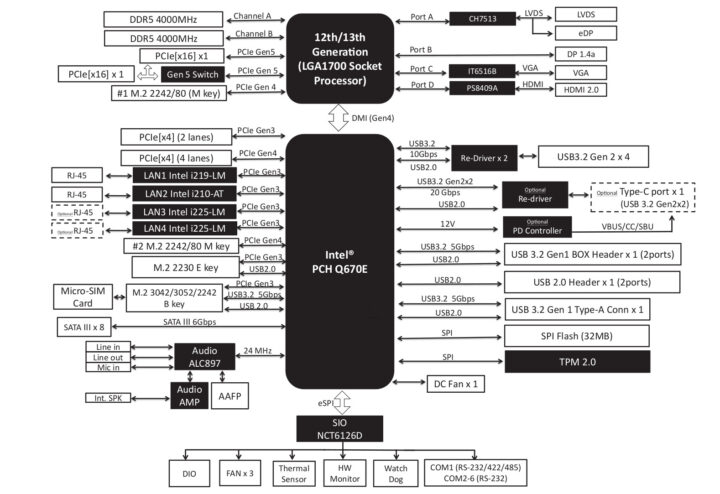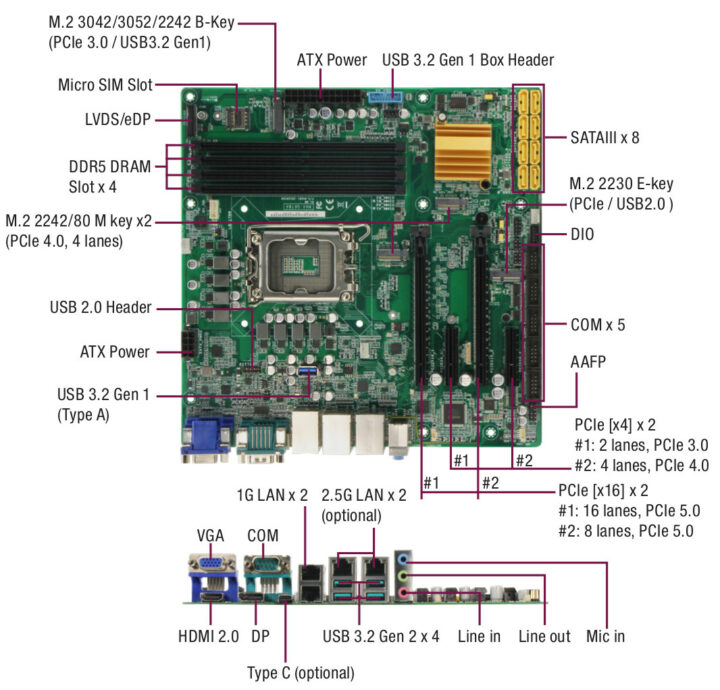AAEON MAX-Q670A is an industrial micro-ATX motherboard that accepts socketed 13th Gen Intel Core Raptor Lake processors, supports up to 128GB DDR5, offers eight SATA ports with RAID 0/1/5/10, up to four Ethernet ports (GbE and 2.5GbE), and two 16-lane PCIe Gen 5 slots.
Other features include five display interfaces with HDMI, DisplayPort, VGA, LVDS, and eDP, four bootable USB 3.2 Gen 2 Type-A ports, an RS232/RS422/RS485 COM port, and plenty of internals headers for more serial and USB ports, as well as M.2 expansion sockets and a digital I/O port

AAEON MAX-Q670A specifications:
- SoC – 12th/13th Generation Intel Core LGA1700 Socket processors (Alder Lake or Raptor Lake) with up to 125W TDP
- Chipset – Intel Q670 Express Chipset
- I/O Chipset – NCT6126D
- System Memory – Up to 128GB via 4x DIMM slots for DDR5 4,000MHz non-ECC, un-buffered memory
- Storage
- 8x SATA III ports with support for RAID 0, 1, 5, 10
- 2x M.2 2242/2280 M-Key sockets (PCIe Gen 4.0, 4 lanes, supports RAID 0, 1, 5, 10)
- 256 Mbit flash for AMI BIOS/UEFI with Wake-on-LAN/PXE support
- Display interfaces
- HDMI 2.0 up to 4096 x 2160 @ 60/30 Hz with digital audio
- DisplayPort 1.4 up to 4096 x 2160 @ 24 Hz or 3840 x 2160 @ 60 Hz with digital audio
- VGA up to 1920 x 1200 @ 60Hz (via IT6516B)
- 18/24-bit dual-channel LVDS up to 1920 x 1080 @ 60 Hz
- eDP up to 3840 x 2160 @ 30 Hz
- Backlight control
- Audio
- Realtek ALC897 6-Channel High Definition Audio CODEC
- 3x audio jacks: Line-in, Mic-in, Line-out
- Speaker header (Line-out), 1x AAFP analog audio front panel
- Networking
- Gigabit Ethernet RJ45 LAN port via Intel PHY I219-LM with support for Intel AMT 12.0
- Gigabit Ethernet RJ45 LAN port via Intel I210-AT controller
- Optional 2x 2.5GbE LAN ports via two Intel I225-LM controllers
- USB
- 4x USB 3.2 Gen 2 ports (10Gbps)
- Optional USB Type-C port up to 20Gbps, 5V/3A
- Note: All external USB ports are bootable and can be deactivated per BIOS function; USB Power switchable feature
- Internal USB interfaces
- 2x USB 3.2 Gen 1 via 2x 2.54mm pitch box headers
- 2x USB 2.0 via 2x 5-pin 2.54mm pitch box headers
- Internal USB 3.2 Gen 1 vertical Type-A port
- Serial
- DB9 COM port with support for RS-232/422/485, 5V/12V/RI
- 5x RS-232 via 9-pin headers
- Expansion Slot
- PCIe Gen 5 [x16] slot (8 Lanes/8 Lanes when dual-use PCIe [x16] slot)
- PCIe Gen 3 [x4] slot (2 Lanes, Open Slot)
- PCIe Gen 5 [x16] slot (8 Lanes)
- PCIe Gen 4 [x4] slot (4 Lanes)
- M.2 3042/3052/2242 B-Key socket (PCIe 3.0 [x1]/USB 3.2 Gen 1) + Micro SIM slot
- M.2 2230 E-Key socket (PCIe 3.0 [x1]/USB 2.0)
- 8-bit digital I/O interface
- Security – TPM 2.0 onboard
- Misc
- H/W Monitor – Temperature Monitor on CPU/Chassis, Voltage Monitor on Vcore/5V/3.3V/12V, Fan Monitor on CPU/Chassis
- Watchdog Timer
- Smart Fan Control
- 4-pin CPU fan connector (PWM Mode)
- 2x 4-pin chassis fan connectors (PWM Mode)
- 3-pin chassis fan connector (DC Mode)
- Power State – S3, S4, S5
- Chassis intrusion
- AT/ATX mode select jumper
- Front panel header
- Clear CMOS jumper
- Onboard buzzer
- 3-pin ME lock header
- LED header for 2x or 4x Ethernet ports
- Power Supply – 24-pin ATX connector, 8-pin ATX 12V power connector
- Dimensions – 244 x 244mm (Micro-ATX form factor)
- Weight – 800 grams
- Temperature Range – Operating: 0°C ~ 60°C, storage: -40°C ~85°C
- Humidity – 0% ~ 90% relative humidity, non-condensing
- Certifications – CE & FCC Class A
- MTBF – 267,950 hours
The company only provides drivers for Windows 10 64-bit and Windows 11 64-bit, so Linux does not seem to be officially supported. We are not told which industrial applications would benefit from the micro-ATX Raptor Lake motherboard, but that would be solutions that require lots of SATA storage with redundancy, multiple video interfaces, high-speed PCIe Gen 5 expansion cards, and plenty of serial ports, as well as the high-processing power delivered by the Intel Alder Lake or Raptor Lake processors combined with a lot of RAM (up to 128GB) to handle the workload(s).

Further information may be found on the product page and press release.

Jean-Luc started CNX Software in 2010 as a part-time endeavor, before quitting his job as a software engineering manager, and starting to write daily news, and reviews full time later in 2011.
Support CNX Software! Donate via cryptocurrencies, become a Patron on Patreon, or purchase goods on Amazon or Aliexpress






DDR5-4000? Why so slow? If you’re going to have to pay the DDR5 premium, at least get some bandwidth improvement out of it.
That’s a ton of I/O of every type, though.
It might have to do with the industrial nature of the product, and the max guaranteed speed of using all 4x DIMM slots (2x can usually be faster).
> the max guaranteed speed of using all 4x DIMM slots
… with single rank memory.
According to an Intel table it could be even worse: “If all four memory slots are filled, dual-rank memory will support up to DDR5-3600“.
Yeah, the limits that are on memory configurations in DDR4 and 5 processors are pretty insane. I wonder why they bother with dual sockets/channel anymore. If you populate both sockets, you can’t get anywhere near the performance you can with a single socket populated. Might as well just save the money and simplify the board layout if that second socket isn’t practically useable anyway. I was looking for a motherboard for my childrens PC recently and I ended up on a board with only two DIMM slots because of this. I wonder when high end boards are going to make… Read more »
> the limits that are on memory configurations in DDR4 and 5 processors are pretty insane
And certain vendors illustrate what this means: soldered DRAM few mm away from the SoC/CPU (talking about Apple’s approach, little idea what the ‘PC world’ is doing)
That’s why I’ll probably go for Mini-ITX if I get another motherboard in the future. Might as well go small. Although you might not save any money.
As soon as I got to the “no linux support”, I stopped reading.